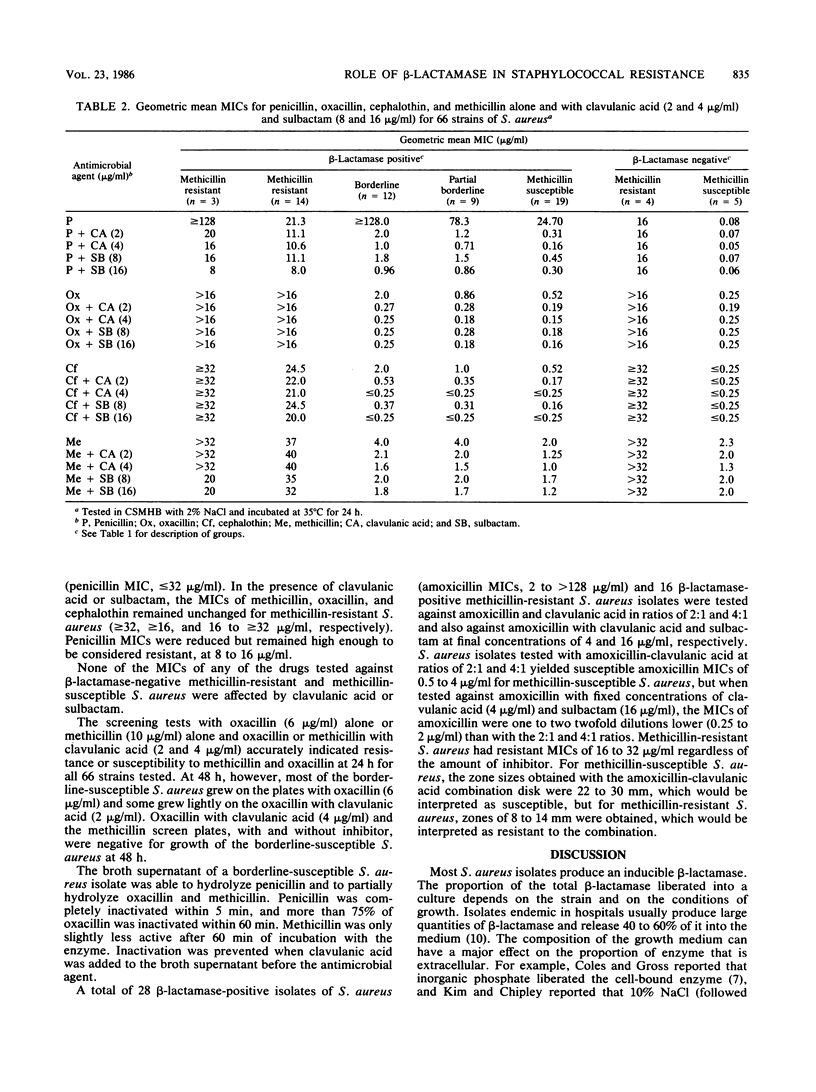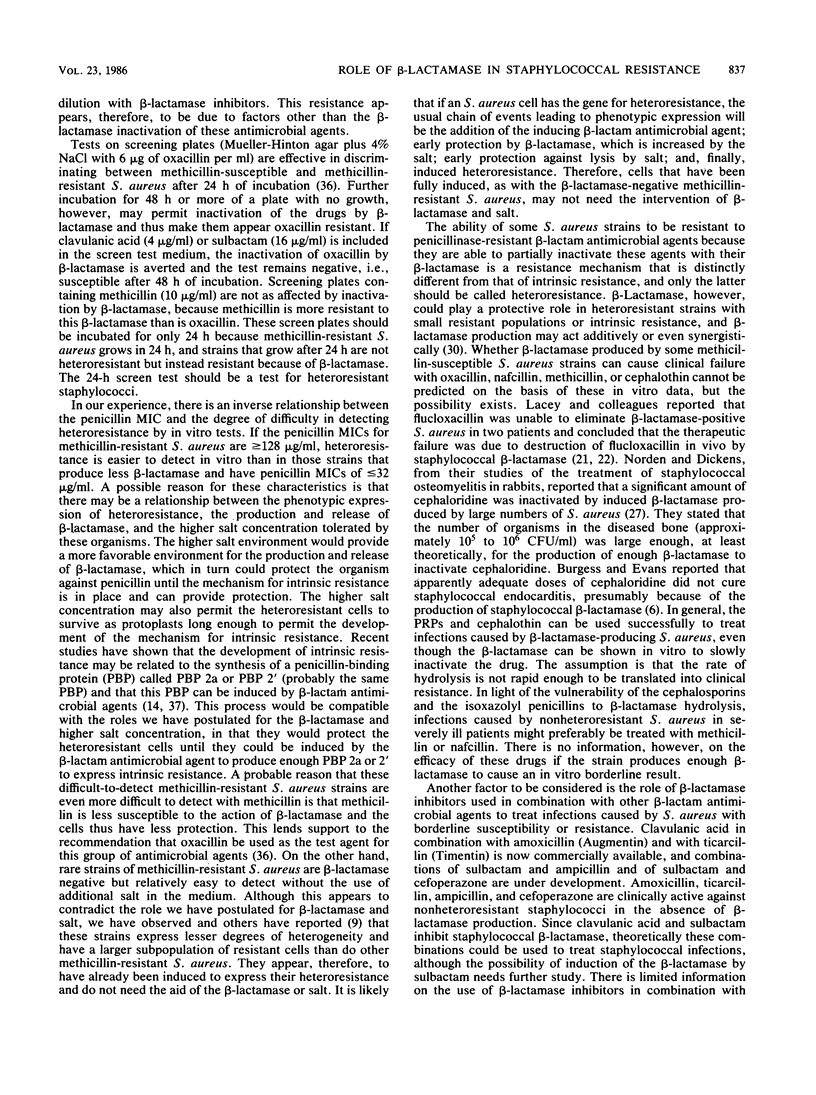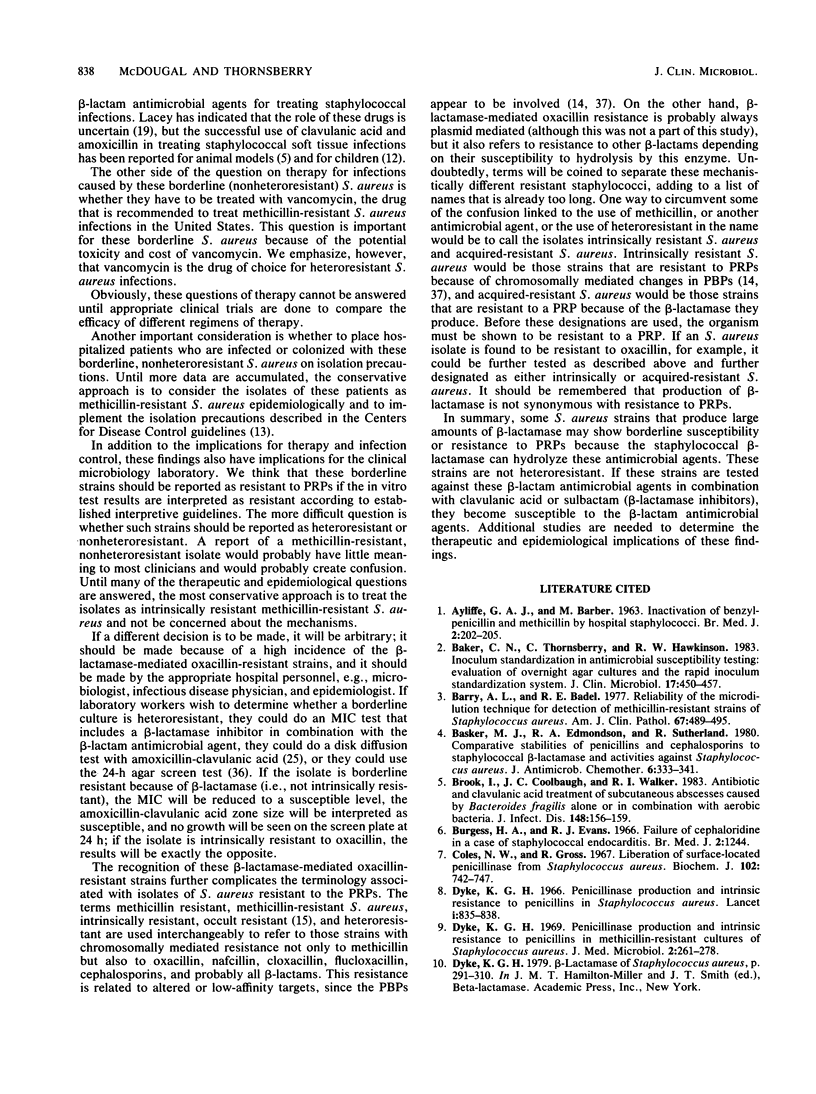Abstract
We showed that most Staphylococcus aureus strains that have borderline or intermediate susceptibility to the penicillinase-resistant penicillins (PRPs) react this way because of the activity of their beta-lactamase on these antimicrobial agents. These strains produced large amounts of staphylococcal beta-lactamase that rapidly hydrolyzed penicillin and partially hydrolyzed the PRPs. Susceptibility to hydrolysis was penicillin greater than oxacillin greater than cephalothin greater than methicillin. The borderline results and the hydrolysis could be prevented by the beta-lactamase inhibitors clavulanic acid and sulbactam. For intrinsically methicillin-resistant (heteroresistant) S. aureus, the inhibitors reduced the penicillin MICs, but the strains remained resistant to all the beta-lactam antimicrobial agents, including penicillin. We conclude that the borderline in vitro susceptibility or resistance to PRPs in most of these S. aureus strains is mediated by beta-lactamase and they are not heteroresistant or intrinsically resistant. We do not know whether this in vitro resistance is expressed clinically.
Full text
PDF







Selected References
These references are in PubMed. This may not be the complete list of references from this article.
- AYLIFFE G. A., BARBER M. Inactivation of benzylpenicillin and methicillin by hospital staphylococci. Br Med J. 1963 Jul 27;2(5351):202–205. doi: 10.1136/bmj.2.5351.202. [DOI] [PMC free article] [PubMed] [Google Scholar]
- Baker C. N., Thornsberry C., Hawkinson R. W. Inoculum standardization in antimicrobial susceptibility testing: evaluation of overnight agar cultures and the Rapid Inoculum Standardization System. J Clin Microbiol. 1983 Mar;17(3):450–457. doi: 10.1128/jcm.17.3.450-457.1983. [DOI] [PMC free article] [PubMed] [Google Scholar]
- Barry A. L., Badal R. E. Reliability of the microdilution technic for detection of methicillin-resistant strains of staphylococcus aureus. Am J Clin Pathol. 1977 May;67(5):489–495. doi: 10.1093/ajcp/67.5.489. [DOI] [PubMed] [Google Scholar]
- Basker M. J., Edmondson R. A., Sutherland R. Comparative stabilities of penicillins and cephalosporins to staphylococcal beta-lactamase and activities against Staphylococcus aureus. J Antimicrob Chemother. 1980 May;6(3):333–341. doi: 10.1093/jac/6.3.333. [DOI] [PubMed] [Google Scholar]
- Brook I., Coolbaugh J. C., Walker R. I. Antibiotic and clavulanic acid treatment of subcutaneous abscesses caused by Bacteroides fragilis alone or in combination with aerobic bacteria. J Infect Dis. 1983 Jul;148(1):156–159. doi: 10.1093/infdis/148.1.156. [DOI] [PubMed] [Google Scholar]
- Burgess H. A., Evans R. J. Failure of cephaloridine in a case of staphylococcal endocarditis. Br Med J. 1966 Nov 19;2(5524):1244–1244. doi: 10.1136/bmj.2.5524.1244. [DOI] [PMC free article] [PubMed] [Google Scholar]
- Coles N. W., Gross R. Liberation of surface-located penicillinase from Staphylococcus aureus. Biochem J. 1967 Mar;102(3):742–747. doi: 10.1042/bj1020742. [DOI] [PMC free article] [PubMed] [Google Scholar]
- Dyke K. G., Jevons M. P., Parker M. T. Penicillinase production and intrinsic resistance to penicillins in Staphylococcus aures. Lancet. 1966 Apr 16;1(7442):835–838. doi: 10.1016/s0140-6736(66)90182-6. [DOI] [PubMed] [Google Scholar]
- Dyke K. G. Penicillinase production and intrinsic resistance to penicillins in methicillin-resistant cultures of Staphylococcus aureus. J Med Microbiol. 1969 Aug;2(3):261–278. doi: 10.1099/00222615-2-3-261. [DOI] [PubMed] [Google Scholar]
- English A. R., Retsema J. A., Girard A. E., Lynch J. E., Barth W. E. CP-45,899, a beta-lactamase inhibitor that extends the antibacterial spectrum of beta-lactams: initial bacteriological characterization. Antimicrob Agents Chemother. 1978 Sep;14(3):414–419. doi: 10.1128/aac.14.3.414. [DOI] [PMC free article] [PubMed] [Google Scholar]
- Fleisher G. R., Wilmott C. M., Campos J. M. Amoxicillin combined with clavulanic acid for the treatment of soft tissue infections in children. Antimicrob Agents Chemother. 1983 Nov;24(5):679–681. doi: 10.1128/aac.24.5.679. [DOI] [PMC free article] [PubMed] [Google Scholar]
- Garner J. S., Simmons B. P. Guideline for isolation precautions in hospitals. Infect Control. 1983 Jul-Aug;4(4 Suppl):245–325. [PubMed] [Google Scholar]
- Hartman B. J., Tomasz A. Low-affinity penicillin-binding protein associated with beta-lactam resistance in Staphylococcus aureus. J Bacteriol. 1984 May;158(2):513–516. doi: 10.1128/jb.158.2.513-516.1984. [DOI] [PMC free article] [PubMed] [Google Scholar]
- Hindler J. A., Inderlied C. B. Effect of the source of Mueller-Hinton agar and resistance frequency on the detection of methicillin-resistant Staphylococcus aureus. J Clin Microbiol. 1985 Feb;21(2):205–210. doi: 10.1128/jcm.21.2.205-210.1985. [DOI] [PMC free article] [PubMed] [Google Scholar]
- Kim T. K., Chipley J. R. Effect of salts on penicillinase release by Staphylococcus aureus. Microbios. 1974 Jun-Jul;10A SUPPL(41):55–63. [PubMed] [Google Scholar]
- Lacey R. W. Antibiotic resistance plasmids of Staphylococcus aureus and their clinical importance. Bacteriol Rev. 1975 Mar;39(1):1–32. doi: 10.1128/br.39.1.1-32.1975. [DOI] [PMC free article] [PubMed] [Google Scholar]
- Lacey R. W., Lewis E. L. Further evolution of a strain of Staphylococcus aureus in vivo: evidence for significant inactivation of flucloxacillin by penicillinase. J Med Microbiol. 1975 May;8(2):337–347. doi: 10.1099/00222615-8-2-337. [DOI] [PubMed] [Google Scholar]
- Lacey R. W. Mechanisms of resistance to beta-lactam antibiotics in Staphylococcus aureus. Scand J Infect Dis Suppl. 1984;42:64–71. [PubMed] [Google Scholar]
- Lacey R. W., Stokes A. Susceptibility of the "penicillinase-resistant" penicillins and cephalosporins to penicillinase of Staphylococcus aureus. J Clin Pathol. 1977 Jan;30(1):35–39. doi: 10.1136/jcp.30.1.35. [DOI] [PMC free article] [PubMed] [Google Scholar]
- Lacey R. W. Treatment of staphylococcal infections. J Antimicrob Chemother. 1983 Jan;11(1):3–6. doi: 10.1093/jac/11.1.3. [DOI] [PubMed] [Google Scholar]
- Lacey R. Stability of the isoxazolyl penicillins to staphylococcal beta-lactamase. J Antimicrob Chemother. 1982 Mar;9(3):239–240. doi: 10.1093/jac/9.3.239. [DOI] [PubMed] [Google Scholar]
- Leggate J., Holms W. H. Gratuitous synthesis of beta-lactamase in Staphylococcus aureus. J Bacteriol. 1968 Dec;96(6):2110–2117. doi: 10.1128/jb.96.6.2110-2117.1968. [DOI] [PMC free article] [PubMed] [Google Scholar]
- McDougal L. K., Thornsberry C. New recommendations for disk diffusion antimicrobial susceptibility tests for methicillin-resistant (heteroresistant) staphylococci. J Clin Microbiol. 1984 Apr;19(4):482–488. doi: 10.1128/jcm.19.4.482-488.1984. [DOI] [PMC free article] [PubMed] [Google Scholar]
- NOVICK R. P., RICHMOND M. H. NATURE AND INTERACTIONS OF THE GENETIC ELEMENTS GOVERNING PENICILLINASE SYNTHESIS IN STAPHYLOCOCCUS AUREUS. J Bacteriol. 1965 Aug;90:467–480. doi: 10.1128/jb.90.2.467-480.1965. [DOI] [PMC free article] [PubMed] [Google Scholar]
- Norden C. W., Dickens D. R. Experimental osteomyelitis. 3. Treatment with cephaloridine. J Infect Dis. 1973 May;127(5):525–528. doi: 10.1093/infdis/127.5.525. [DOI] [PubMed] [Google Scholar]
- O'Callaghan C. H., Morris A., Kirby S. M., Shingler A. H. Novel method for detection of beta-lactamases by using a chromogenic cephalosporin substrate. Antimicrob Agents Chemother. 1972 Apr;1(4):283–288. doi: 10.1128/aac.1.4.283. [DOI] [PMC free article] [PubMed] [Google Scholar]
- Parker M. T., Hewitt J. H. Methicillin resistance in Staphylococcus aureus. Lancet. 1970 Apr 18;1(7651):800–804. doi: 10.1016/s0140-6736(70)92408-6. [DOI] [PubMed] [Google Scholar]
- RICHMOND M. H. PURIFICATION AND PROPERTIES OF THE EXOPENICILLINASE FROM STAPHYLOCOCCUS AUREUS. Biochem J. 1963 Sep;88:452–459. doi: 10.1042/bj0880452. [DOI] [PMC free article] [PubMed] [Google Scholar]
- Reading C., Cole M. Clavulanic acid: a beta-lactamase-inhiting beta-lactam from Streptomyces clavuligerus. Antimicrob Agents Chemother. 1977 May;11(5):852–857. doi: 10.1128/aac.11.5.852. [DOI] [PMC free article] [PubMed] [Google Scholar]
- Reading C., Hepburn P. The inhibition of staphylococcal beta-lactamase by clavulanic acid. Biochem J. 1979 Apr 1;179(1):67–76. doi: 10.1042/bj1790067. [DOI] [PMC free article] [PubMed] [Google Scholar]
- Retsema J. A., English A. R., Girard A. E. CP-45,899 in combination with penicillin or ampicillin against penicillin-resistant Staphylococcus, Haemophilus influenzae, and Bacteroides. Antimicrob Agents Chemother. 1980 Apr;17(4):615–622. doi: 10.1128/aac.17.4.615. [DOI] [PMC free article] [PubMed] [Google Scholar]
- Thornsberry C., McDougal L. K. Successful use of broth microdilution in susceptibility tests for methicillin-resistant (heteroresistant) staphylococci. J Clin Microbiol. 1983 Nov;18(5):1084–1091. doi: 10.1128/jcm.18.5.1084-1091.1983. [DOI] [PMC free article] [PubMed] [Google Scholar]
- Utsui Y., Yokota T. Role of an altered penicillin-binding protein in methicillin- and cephem-resistant Staphylococcus aureus. Antimicrob Agents Chemother. 1985 Sep;28(3):397–403. doi: 10.1128/aac.28.3.397. [DOI] [PMC free article] [PubMed] [Google Scholar]
- Watanakunakorn C. Effect of inoculum size on in vitro susceptibility of methicillin-resistant Staphylococcus aureus to eighteen antimicrobial agents. Eur J Clin Microbiol. 1985 Feb;4(1):68–70. doi: 10.1007/BF02148668. [DOI] [PubMed] [Google Scholar]


